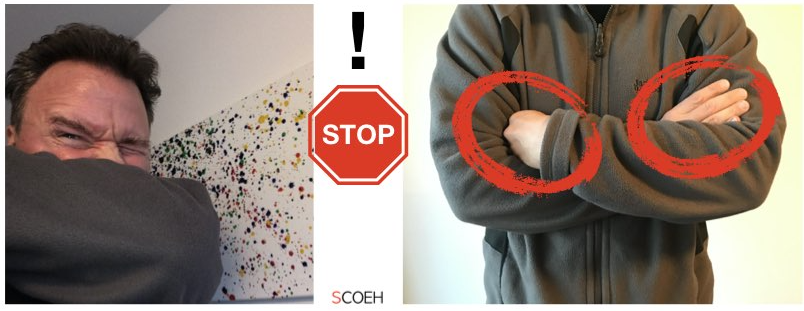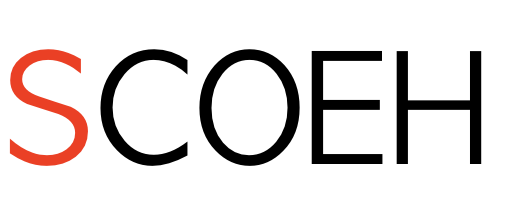A couple weeks ago, I was at a public toilet with my two young kids. While we were carefully washing our hands, we saw a strange looking guy heading from his toilet cubicle straight to the door as if he was allergic to water and soap. My kids were shocked and wondered: how can we get past that door while keeping our hands clean?
It is not enough to wash your hands. You also have to keep them clean and know when to wash them again. Toxic chemicals and biohazards are frequent in occupational settings, leaving traces on surfaces and workers’ hands and gloves. So what can we learn from the Occupational Health and Safety experience? What can individuals, companies and maintainers of public installation do?
First we must identify what and how surfaces can get contaminated; and second we must apply the STOP-approach – Substitution, Technical, Organisational, Personal.
S as in Substitution:
This usually refers to changing a hazardous chemical against a less toxic one, but it can also apply to processes and tools. We can’t substitute the corona-virus, but we can substitute the hand by the elbow to touch a button, or by a namaste to greet others.
T as in Technical:
The use of technical measures can reduce the risk of contamination. Most of these approaches require that employers, public authorities or residential management implements them.
- Door opening: It may not be possible to install automatically opening doors, but you can remove or prop open doors, remove the door bolt so people can open the door by foot, or replace the door handle with one that can be operated with the elbow.
- Hand washing: If you happen to plan a new worksite or public toilets, get water faucets and soap dispensers that can be operated touch-free with a sensor. Also working are faucets that shut off after a brief time so that you don’t have to turn off the water with your clean hands. All other situations, require creativity to find ways to allow operating the faucet by foot, knees or elbow.
- Trash bins: Some countries recommend to dispose used handkerchiefs into closed trash bins. But this is a recipe for contamination if you need to open the lid by hand. Use closed bins ONLY if you can open them without the hand and put a big sign on the lid that says „do not touch by hand, use your foot only to open“. Otherwise it is much safer to stick to open trash bins. Oh, and don’t forget to to place your bin in a way that nobody can knock it over by mistake, and that cleaners can empty it without needing to touch the contents.
O as in Organisational:
The way you organise your activities has an important influence on your risk to get contaminated. There are a few fundamental rules:
- Separate bystanders from the hazard by setting up restricted zones. The easiest one is to work from home if possible and to leave home only for essential chores. In companies, we have to consider every other person as a potentially hazard. Thus, avoid unnecessary contacts and allow eating boxed lunches at the personal desk IF the desk is not in a zone with specific hazards such as chemical or biological agents.
- Create clean zones. People who cannot work from home should, if ever possible, get dedicated workplaces with access only for that person. Nobody else should approach it, no boss, no cleaner. Each person will have to be in charge to keep his or her own workplace clean.
- A possibility for washing or disinfecting hands needs to be provided at places where people enter or leave a zone that is outside their direct and sole control. Those maintaining facilities need to regularly disinfect door handles, stair railings, poles, tables, and other surfaces that people may touch.
- Set it up for longer term: Before you start providing disinfectants or other (personnel-intensive) solutions, make sure that you have the sources to do this over a prolonged time, and secure your material against theft.
- If you run a personnel restaurant, be extra careful. All kitchen staff must wear masks to not contaminate food or surfaces. The only thing the guests should touch are their own tray, glass, plate and cutlery. So avoid piles of plates or buckets with cutlery. Hand these over by staff wearing masks and clean gloves.
- If you have staff kitchens for preparing coffee, tea or warming lunch boxes, be extra careful. Restrict the number of staff in that room, regularly disinfect all surfaces and ask staff to wash or bring their own cups, cutlery etc. and to store it in their personal „clean zone“.
P as in Personal protection:
Personal protection approaches are the last line of defense for situations where all other means to prevent contamination are exhausted, but also as a safe-fail measure.
- Use a handkerchief to sneeze, avoid using your armrest. This must remain an emergency measure! Use only one armrest for sneezing so that you can use the other arm’s elbow to touch surfaces. Else you will become a super-spreader!
- Never fold your arms, especially not when your hands are dirty or if you have the habit to sneeze into the armrest!
- Use gloves when your job requires you to touch surfaces that are near people. Remember, infected people can deposit the virus not just by touching but also by breathing, talking or sneezing, and learn how to remove gloves correctly (see e.g. U.S. CDC)
- Use plenty of disinfectant or wash your hands before and after touching touch-screen surfaces, e.g. at the photocopier.
- Use disposable towels to open doors. Once used, fold the towel without touching the contaminated side, and dispose it in a trash bin. Do NOT put it in your pocket for another use!
To close off with the toilet experience I had with my kids: I showed my kids the trick of using a paper hand towel to pull open the door. My kids talked and joked about this experience for days. So when the corona-virus came, I used it to explain why they have to keep their hands clean by not touching surfaces in public: „just imagine, a person with corona has hands like this guy. Don’t touch door handles, hand rails, lift buttons, shopping carts and other surfaces, unless you can wash your hands afterwards!“. And it works! My kids are now very carful during the rare times we are outside our apartment.

Modified on 24 March: I added “if ever possible” to the concept of clean zones. Not all professions are static and safe work can be organised even if space is sometimes shared with others. I also added “washing hands” as alternative to disinfectant touch-screen surfaces (put in bold), which should be of course done before and after touching.
